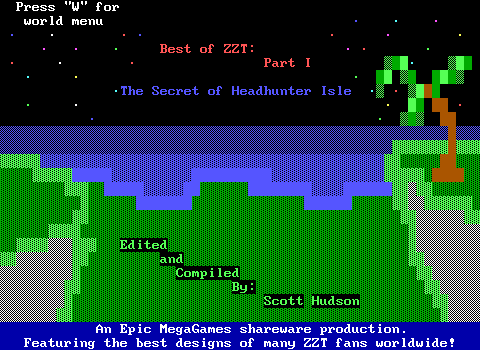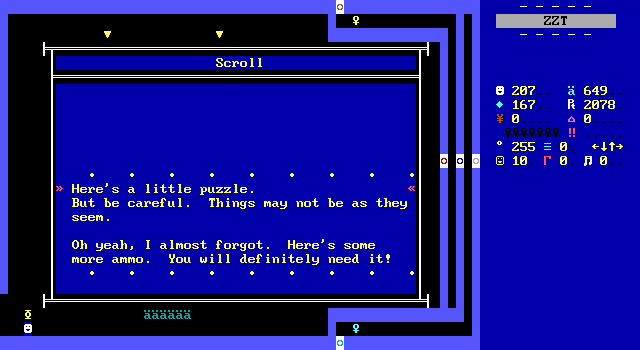
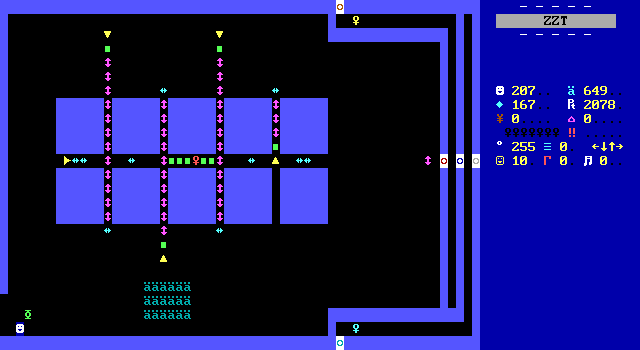
Another crack is taken at creating a puzzle, which at first glance looked like it was going to be another flop. The only moves available are to push a cyan slider and activate some pushers in order to allow the horizontal one to move across and push the red key out.
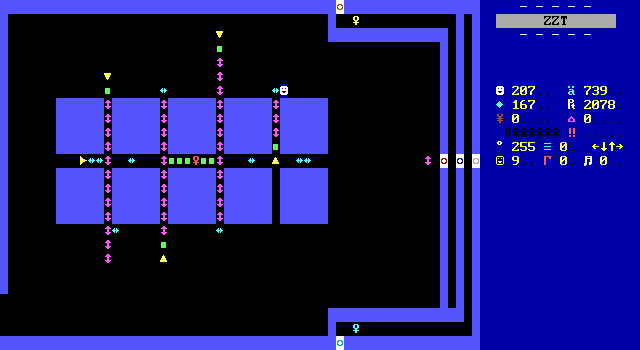
The Roberts' have their own plans though! The horizontal sliders are secretly objects, and touching one will cause a different one to move! This doesn't change the solution, you still need to touch all the "sliders".
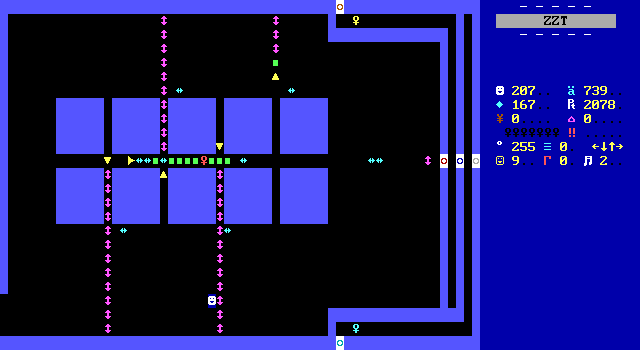
But it does mean that if you aren't paying attention you can actually get trapped! This is it. It's a puzzle. You can screw it up, and I did.
Pushers aren't exactly quick, so just walking away is all it actually takes to keep yourself from getting penned in. Alternatively, I'm sure you can press them in a specific order to avoid the potential for getting trapped here.
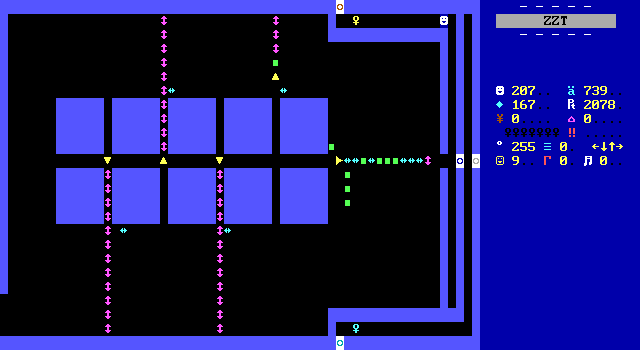
Once the key has been collected, the Roberts try something else that's a little bit different from what's been seen so far. The actual way forward is to the east, but in order to get there two paths have to be traveled for keys. I do wish they had made both the north and south paths open up simultaneously as while this is the first time the player will have to return to a previous board, it's still a fully linear experience. Going from A->B or B->A wouldn't really make any difference, but just offering up a choice to the player would give this otherwise quite straightforward game something to make it feel like the player has any control over where their adventure takes them.
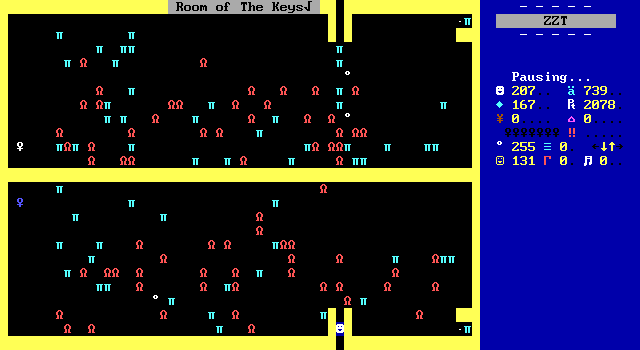
Although, when this is the room Cowhead finds himself in next, I guess even the illusion of choice wouldn't work. Both exits connect to this board from two different sides, with the same cluster of lions and tigers protecting a key.
Getting through each half of this board is the most pronounced action yet. My health had recovered enough that I was at least willing to risk wading into the fray a little bit to speed up the process of clearing the creatures out. Perhaps I have a soft spot for piles of monsters like this that are sufficiently scattered. I was impressed at the intensity of All Out War from The Lost Pyramid, and I'm an avid fan of the Link's Adventure trilogy. Both of those examples excel through more creative layouts though. This is really just an excuse to shoot a few hundred bullets. Like the narrow hall of ruffians seen towards the start of the game, it lets the player feel unstoppable. By the time the player is going after the second key here, the shine has worn off resulting in a board that's notable only for the sheer number of enemies on it, and not the experience of fighting them.
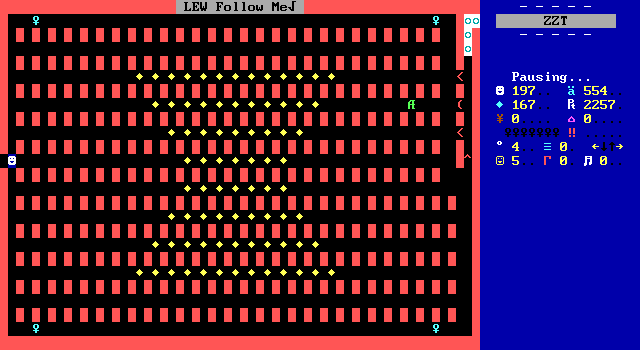
Once both sides have been robbed of their keys, Cowhead can boldly go forward to rob more keys. As is expected, there isn't much going on here. The board does at least look quite different than the rest with its hourglass figure of gems arranged in a red grid. Beyond the looks, it's another board with another set of keys. Ho-hum.
The opponent this time is a rehash of the red circles seen just a few boards prior. This one has a few advantages that make it more dangerous. It moves at maximum speed which allows it to capitalize on the slightest hesitation by the player. It also uses #go so it can also push those gems that might otherwise be an easy way to get the object stuck, or at least slowed down.
Getting caught will cost players three health, but also get the object to stop moving for a moment, a necessity at cycle one in order for players to reliably escape. As with the circles, the seeker is also invulnerable, but taking shots isn't a complete waste. A successful hit will pause the object for twice as long as the pause from being attacked. By this point Cowhead will have hundreds of ammo and can fire pretty liberally to maintain a safe distance.
The Roberts also aid the player by recognizing the potential to getting stuck easily when opening one of the four doors that protect the exit. A series of transporters are set up to make sure that players won't get stuck. This is a welcome design choice that a lot of newcomers wouldn't think to include, which makes it rather odd to me that the circles seen earlier are specifically designed to defeat the player by getting them stuck in a corner. Maybe each Robert made one of these boards. Maybe they came up with the transporter solution later on. Maybe they were just throwing things at the wall and seeing what stuck.
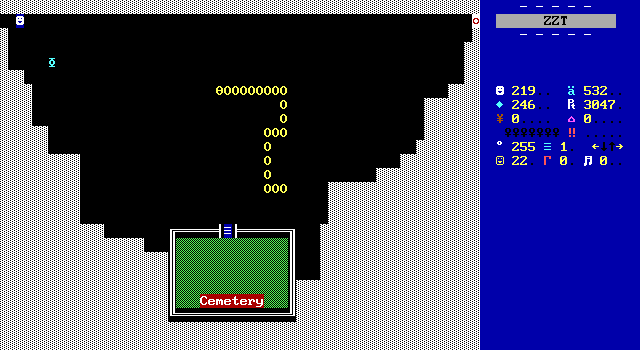
Everything up to this point has been very abstract. Cowhead's journey isn't really "through" anything, and even the boards with catchy names keep that information to the editor. So it's quite a surprise at this point to suddenly by outside a cemetery. A real location rather than a manic series of conveyors and duplicators. The look is also very different, breaking away from the rigidness seen pretty much everywhere else and using more of a carved out approach that doesn't just fill the board with solid walls at right angles.
The obligatory early-ZZT giant centipede is on full display as well, though quite modest in length. A large centipede the size of a small centipede.
There's this slow realization coming to the Roberts that ZZT boards can in fact be places, even if they're still heavily gameified. The Rio Grande is perhaps the only board prior to the cemetery that you could point out and say what it is. Is this the beginning of a new era?
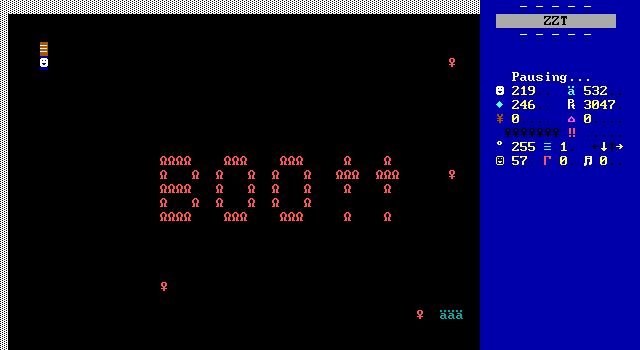
This is my new favorite arrangement of lions.
The cemetery is an honest to goodness arrangement of four boards that the player can traverse in order they choose as they hunt down the red key to proceed along the main path. To prevent the player from just running to the key and exiting, the place is littered with fake red keys that disappear and say "Boo!!" when touched.

While the first screen doesn't scream "cemetery", (it screams "Boo!!",) the other boards are lined up with small tombstones giving this game some real setting.
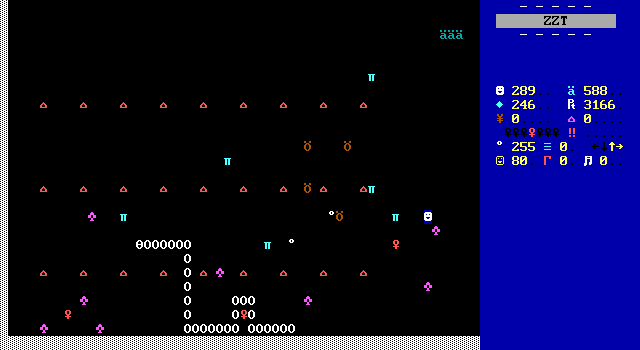
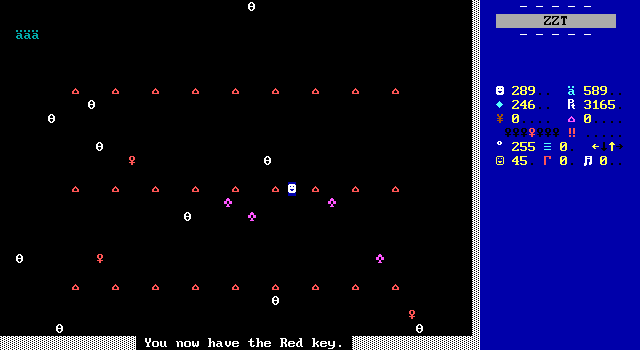
Alas, that's really all it does. The biggest issue with Cowhead remains its lack of variety, and this is the game finally breaking away from what it's been doing and oops, it's actually worse. These boards feel very low effort in a way that the other boards, even if frequently derivative of one another, do not. This truly is just haphazardly placed enemies in a lifeless (pun intended) environment.
This isn't even all that difficult of a setting to turn into a location for an action game! Those un-killable enemies in previous boards? Place them here and call them ghosts. Have the player search the graves for keys instead of making the tombstones no different than walls. Toss in a mausoleum to house the red key and feel free to do what Cowhead has been doing with another action screen with conveyors or blink walls or something.
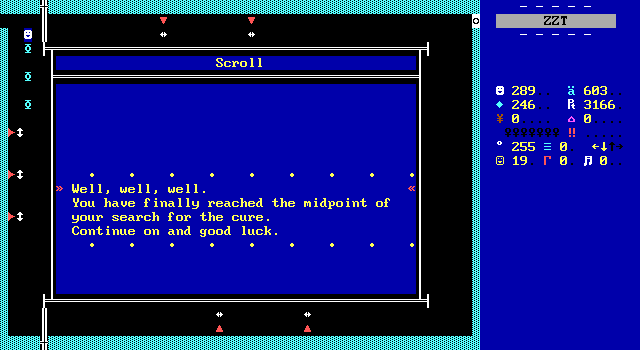
This is a lie, which at this point I am thankful for. "The Room You Love To Hate" is board number eighteen out of twenty-five. Things are actually wrapping up here. Perhaps there were grander plans for Cowhead and fatigue set in. The message could use some updating in that case, but twenty-five board of Cowhead feels like plenty to me.
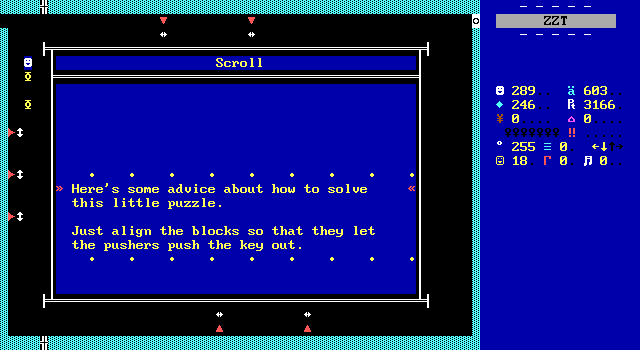
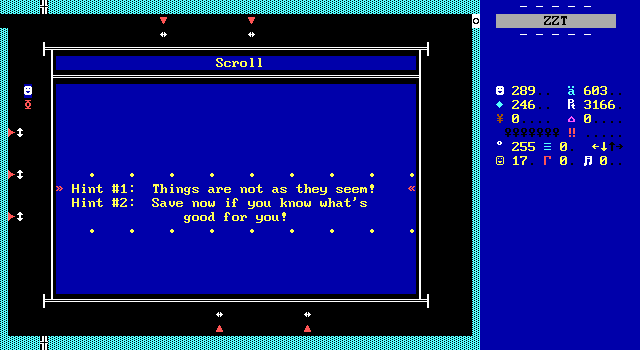
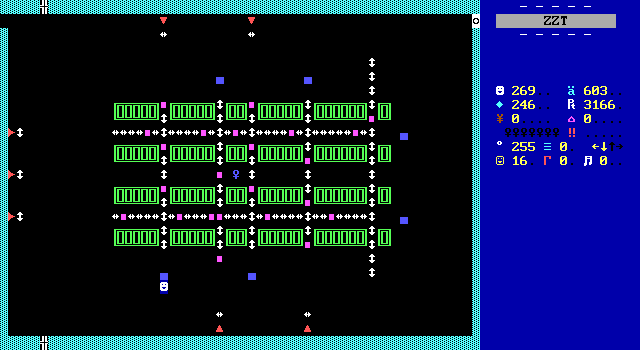
Enter slider puzzle number three. The first was a dud, but just a tiny portion of an otherwise decent enough board. The second relied on tricking the player a little, while still being very straightforward. Can the third attempt offer up any real resistance to being solved?
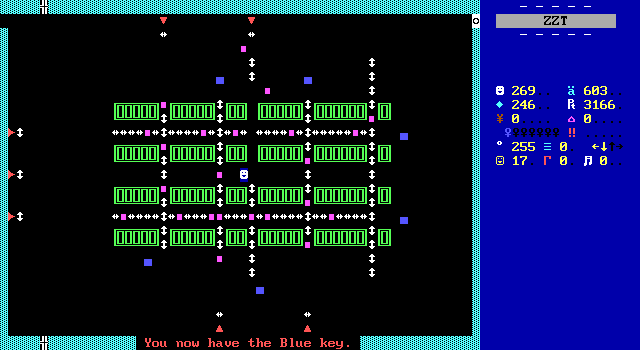
Not at all.
It's another instance of a slider puzzle that has an intended method of solving which involves using the pushers to line things up, and these new blue objects that basically act like boulders but can't be pushed to be able to stop the pushers when necessary.
Instead, the player just gets to push a column of sliders until a boulder is exposed to outside the mechanism and then just hop in themselves to grab the key.
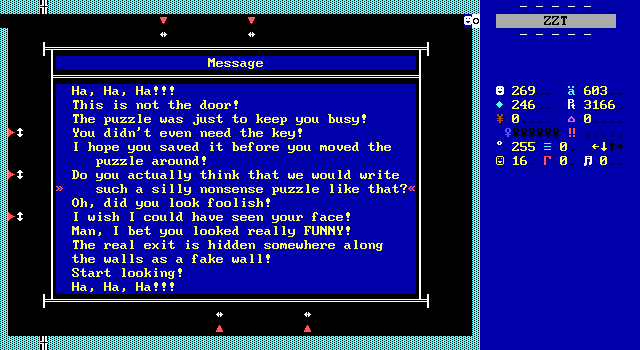
Betrayal
So it's another joke. The door is in fact just an object on a black background and my wrinkled eyes can't tell without looking closely.
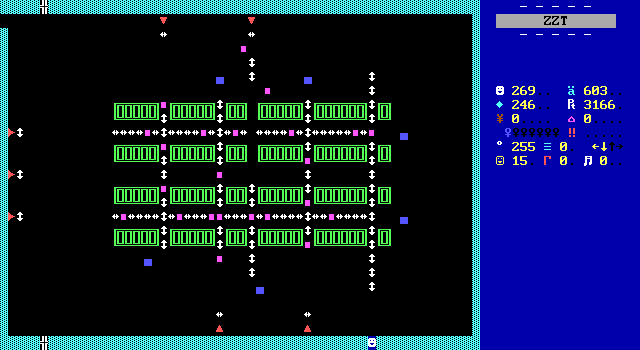
Once you find the fake wall exit it becomes clear why the puzzle still needed a save warning. I imagine the "proper" solution to this puzzle means pushing the sliders up against the fake wall and prevents the player from actually leaving. In fact, not only do you not need the blue key to leave the room, but I don't think you're supposed to get it at all.
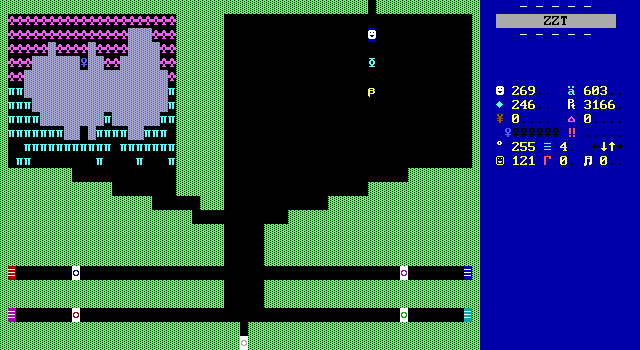
My hunch is based on the next board having a huge number of monsters by a small body of water that also has a blue key. If I wanted to here, I could just use my key from the puzzle and ignore them entirely.
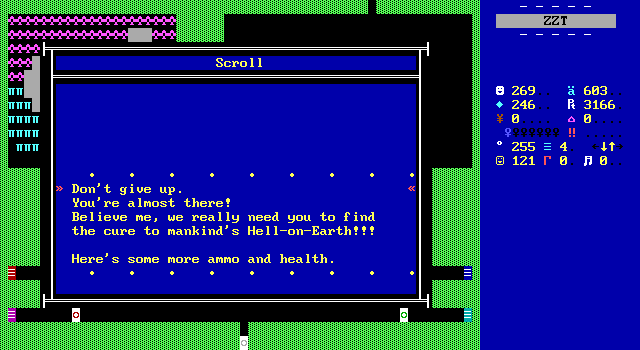
From halfway to almost there in a single screen. The scroll gives one final reminder of the importance of Cowhead's quest, and one last boost to the player's supplies before they take on the game's final challenge.
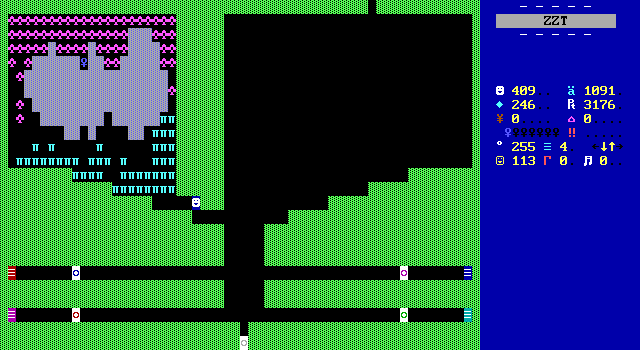
Not the tigers and ruffians. Those passages down there are another instance of a linear set of boards to get keys in order to unlock the white door and enter the penultimate board of Cowhead.
But first, tigers and ruffians because even with the key I wanted to play this out. The shape of the path the player follows allows for some pretty safe shooting as tigers slowly head down towards the player. Once they've mostly taken care of it's easiest to just head up to the water and take shots at ruffians on the other side without fear of being ambushed.
The blue key is intended to unlock a rather disappointing series of challenges.
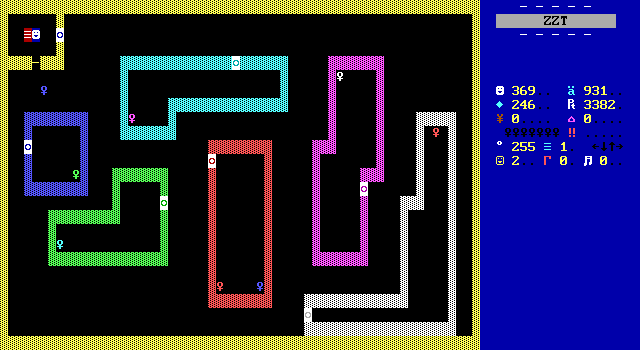
The yellow borders make a return, though at least accompanied by all the other colors ZZT offers creators. Challenge number one is to not bore yourself to death. I had assumed the smaller rooms that contained the keys would be filed with tiny invisible mazes. Something that thankfully is not the case. Yet even if things could be worse, they could certainly be better. There's nothing to impede the player here. You grab the key, open the door, and grab the key. Eventually you use the red key to open the red door and get two keys, one for the exit (that horizontal line is a transporter), and the other for the second of these four challenges of the lake.
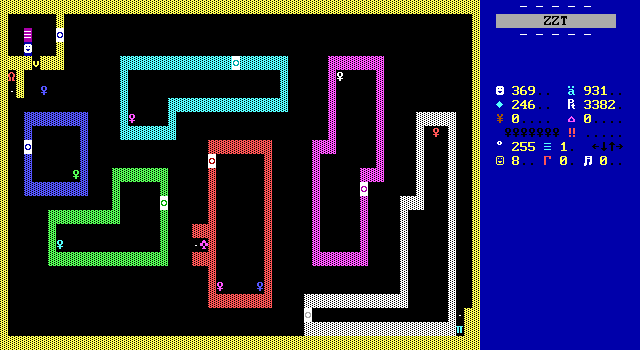
The second challenge I guess addresses my complaint. Yes, the board is identical to the previous one, except the final key color has been changed and now some duplicators give Cowhead a reason to shake a leg. This is "better". It is still not good. The enemies fill the room fairly slowly and aren't all that threatening, especially considering the ammo and health recently given. Had the rooms with the keys contained the enemies, and there might be something to this.
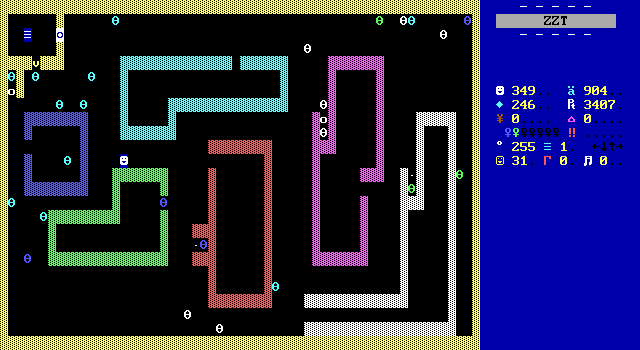
As for the third challenge? Centipedes. They do have a habit of turning to dodge bullets before they hit. Besides that, this is probably easier than the last as ruffians and tigers tend to have the best offensive capabilities.
If you haven't scrolled enough to see the fourth and final of these challenges, try and guess what it might be.
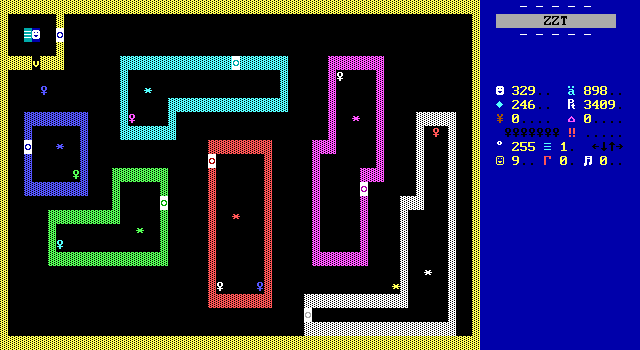
It's slimes.
Ironically they are placed inside the smaller rooms! This turns challenge number four into nothing more than a test of how much ammo the player has. Since Cowhead likes to arm the player with hundreds of bullets at a time, there's still nothing to worry about here.

Had the ammo been a little less generous though, there might have been. It took me a moment to realize there was a yellow slime that would fill the outer area as well, making it important to stop its spread before grabbing the rest of the keys. Were the room to actually fill up, the player might need a few hundred bullets to tunnel through everything.
With the final key in hand, it's time to end this strange quest.
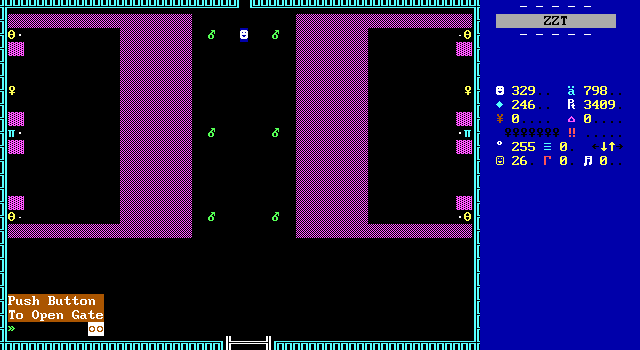
Heck yeah, back to the classics.
Gotta get those keys and bomb those duplicators. Then again, maybe you shouldn't be so hasty.
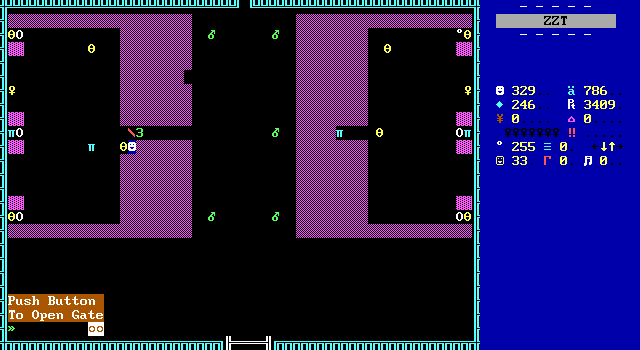
After showing so much restraint, the Roberts have finally decided the player can deal with some star-throwing tigers. Their stars will push the bombs backwards which makes it rather difficult to actually get a bomb inside. The tiger on the opposite side of the board is a bullet-shooter, so I'm unsure if the mixture was deliberate or not.
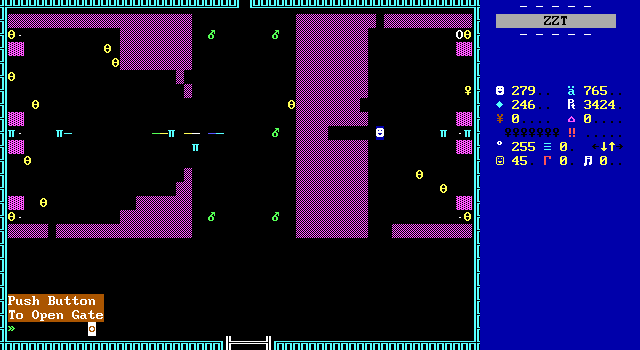
It quickly becomes apparent that it's easier to just grab the key and run, and then to use the breakables as a shield to protect the player from the stars.
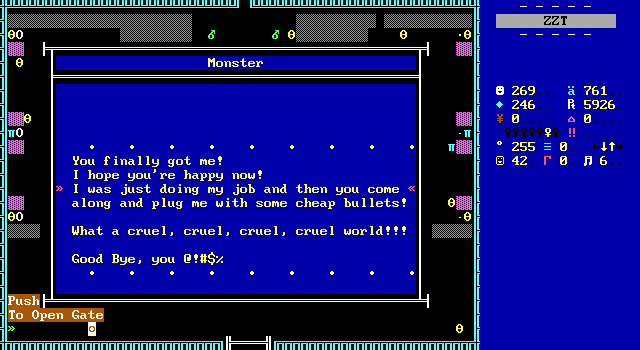
Through an incredible coincidence I also managed to defeat the final boss that I didn't know was a thing. I love their farewell text at least!
The message should read...
Now you're in for it!! There is a
guardian taking care of the gate.
To pass, you must kill it. Kind of
bloody, huh?
Oh, it's invisble and you gotta
shoot it twice!!
Pretty cool, huh?
• • • • • • • • •
Touching the button to open the gate makes it a bit clearer what just happened. The button doesn't open the gate, but rather awakens the invisible monster boss. The invisible monster boss opens the gate when defeated. Except while the invisible monster is just chilling, nothing prevents the player from shooting them and one of my bullets just so happened to hit them. This is compounded by a coding error which causes the monster to not return to its main loop when shot, instead continuing down past additional :shot labels and reaching the victory text.
While I am glad I didn't have to fight an invisible monster (who would otherwise constantly move randomly while shooting at the player), it's a shame that this wound up being how my Cowhead game drew to a close. Yet I can't say I was interested in restarting to see the fight play out. Cowhead had its moments, but I was getting the feeling the both myself and the Roberts were ready to move on.
The only thing left to do was to find the cure for society's nightmare or whatever. Onward brave Cowhead!
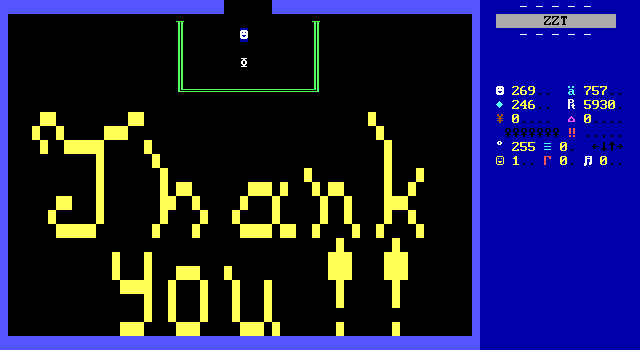
Cute text. No animations or anything. Just a single scroll for the epilogue.

Oh.
Yeah so the whole game is just a period joke. This may have played a part in why I decided against the whole "This game can be the first subject of a video history of ZZT" thing.
Also no game over. You're just left hanging here. THE END NO MORAL.
Final Thoughts
Cowhead is certainly an odd one. It has its share of items worth praising. The game focuses on action and those boards do a reasonable enough job of creating some fun gameplay for players. Unlike many early ZZT worlds, it's actually quite generous with health and ammo. Most boards with enemies to fight manage to avoid just flooding a room with enemies, instead putting some thought into what foes would complement the design of the room. Pretty much all of the action boards taken individually are perfectly playable and enjoyable to shoot your way through.
The jokes give the game a unique aspect that's hard to come by in most worlds, giving it a slight edge over the many similar games out there. The jokes certainly don't turn this into anything great, but they make it feel distinct, even if I don't think anybody will crack up over them today. The Roberts try to integrate humor into the adventure itself with some puzzles to tease the player without making anything frustrating. It's all in good fun here. This is definitely a game that should be easy for almost anyone to get through, regardless of age or ZZT experience. In this way, it feels a little bit ahead of its time.
Unfortunately, while I think the Roberts meant well and were trying their best, Cowhead doesn't really stand out in any meaningful way. Everything about the game is purely average feeling at best. The only things that wowed me were the few attempts that actually deviated from the key collection boards, solely because they weren't more key collecting. You can play this game from beginning to end and it will be a positive experience overall. The puzzles are too busy trying to subvert the player's expectations, but the only real subversion is that you're not actually getting a change in gameplay. You're just moving on to the next screen with its creatures behind duplicators.
Back in the day, I think the authors' understanding of how to make a fun action sequence probably would have been enough for the game to be well received, if certainly not on the level of those worlds that won positions in official ZZT releases from Epic. The world feels amateurish, but promising. It's just too derivative of itself to find success. I can see why somebody that acquired it back in 1991 would have hung onto it, allowing it to continue forward through the years. The only thing that goes from subpar to actually feeling awful is the shooting gallery board. The attempt to mix things up with the cemetery end up falling flat as the area doesn't seem to have the care the rest of the game had, and going by the copy and paste design of the final sequence seen shortly afterwards, I believe this is just the authors wanting to be done with the game already. Playing it for yourself, you'll likely feel the same way.
Cowhead's one claim to fame, being the oldest preserved ZZT world not published by Epic, has been stripped in recent years, leaving the game without an identity. It's a very safe game that figured out a way to make a good enough action screen and was too reluctant to try and do anything else. Other 1991 games such as Outskirts of Zweldronia! and Inn of the Cow are a lot more bold with what they try to do, so that even when they stumble, you can't help but admire their ambition. Cowhead never really pushes things forward, resulting in a very samey experience, that while reasonable in a few instances here and there, can't carry an entire game. A good try, but one that needs a creative push whether by story, setting, or just adding some variety to the kinds of boards included in order to make it something really worth the player's time rather than a novelty from ZZT's first year.

